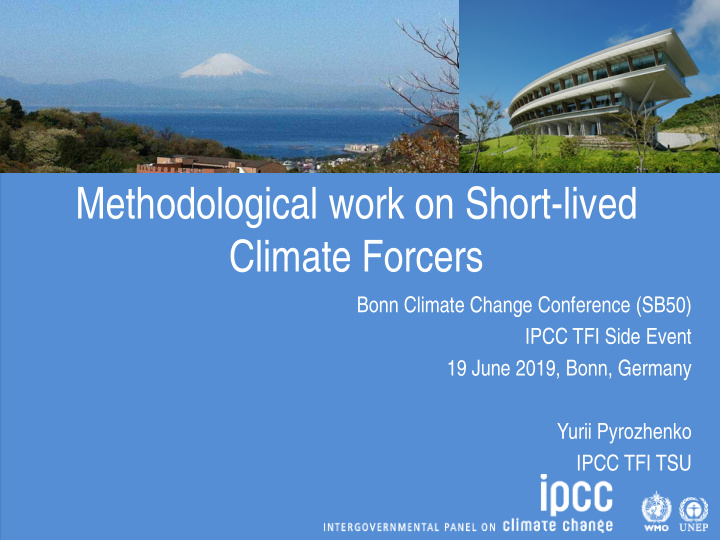



Methodological work on Short-lived Climate Forcers Bonn Climate Change Conference (SB50) IPCC TFI Side Event 19 June 2019, Bonn, Germany Yurii Pyrozhenko IPCC TFI TSU
Outline Expert meeting on SLCF held in May 2018 • Background • Coverage of SLCF species • Outcomes • Conclusions and recommendations Future work on SLCF inventories decided by IPCC-49 in May 2019 • Related to AR6 cycle • Related to AR7 cycle
Expert meeting on SLCF held in May 2018
Background Science on SLCFs has significantly advanced since the IPCC Expert Meeting on Emission Estimation of Aerosols Relevant to Climate Change was held in 2005 At the 45 th Session in Guadalajara (March 2017), some member governments proposed on work of IPCC, among others: development of robust inventory methodologies on estimation of SLCF emissions At the 46 th Session in Montreal (September 2017), IPCC decided to hold an expert meeting on Short-lived Climate Forcers to discuss issues on estimation of emissions and climate effects (Decision IPCC/XLVI-6) The meeting, organised jointly by TFI and WGI, took place on 28-31 May 2018 in Geneva, Switzerland
Coverage of SLCF species (1) Aerosols: Black Carbon (BC) Organic Carbon (OC) PM 2.5 Precursors: NO x CO NMVOC (including BVOC) SO ₂ NH ₃ CH ₄ and HFCs are already covered in 2006 IPCC Guidelines and its 2019 Refinement, therefore these SLCFs were not considered
Coverage of SLCF species (2) Most of SLCF species considered are included in existing non- IPCC guidance (e.g. EMEP/EEA and AP-42) The only exception is OC that generally is not accounted for due to methodology and data gaps In addition, the current approach to derive BC emissions as a fraction of PM 2.5 or PM 10 (e.g., in EMEP/EEA Guidebook) might need elaboration due to significant variability in observed BC/PM 2.5 ratios Existing guidance does not cover all global sources and is not yet globally-applicable
Outcomes Meeting Report was published on TFI website: https://www.ipcc-nggip.iges.or.jp/public/mtdocs/1805_Geneva.html) The outcomes of the meeting: will be used as a basis for future work of TFI are expected to feed into the WGI AR6 report, primarily in Chapter 6 (Short-lived climate forcers) but also Chapter 7 (The Earth’s energy budget, climate feedbacks, and climate sensitivity)
Conclusions and recommendations (1) Science has advanced. Need has arisen. Since AR5, progress has been made in: improved definitions of OC and BC increased understanding of non-combustion aerosol sources amount of measurements on aerosol particle sizes better model parametrisations of aerosol processes Improved SLCF emission inventories and methodologies are necessary: to increase accuracy of SLCF emission estimates to enhance scientific understanding and assessment of their role in climate change; as well as to inform climate policy at the national and international levels, particularly through UNFCCC
Conclusions and recommendations (2) IPCC can play an important role. Internationally-agreed, globally applicable methodologies and emission factors for SLCF emission inventories are necessary The IPCC can play an important role because of its unique position, therefore considered to be the right organisation to fill gaps in existing methodologies and to develop and disseminate an internationally-agreed, globally applicable methodological guidance based on existing methodologies This could be achieved in close cooperation and collaboration with other relevant international bodies
Conclusions and recommendations (3) All SLCFs should be considered. Some SLCF species are of key importance globally and/or regionally for climate change (e.g. CH 4 , NOx, OC, BC and SO 2 ) Others may become a high-priority over time in terms of mitigation strategies (e.g. NH 3 and VOC) In order to take into account trends and developments, all SLCFs should be considered with more focus on species and sources that are not well covered in existing guidance
Conclusions and recommendations (4) Careful consideration is required in consolidating existing inventory methodology. If the IPCC Plenary decides to engage into further work on SLCF inventories, careful consideration needs to be given to possible issues in consolidating existing inventory methodologies on GHGs and SLCFs Generally, much of the existing good practice guidance on GHG inventory is applicable to, or can be a good basis for, SLCF inventories at a national level For some emission sources, however, existing inventory methodology does not provide a good basis for SLCF inventory
Conclusions and recommendations (5) SLCF reporting should be in mass units, not in CO 2 -eq. Reporting of SLCF inventories should be in mass units for each individual emitted compound SLCF emissions should not be converted to CO 2 equivalent units in the same way as done based on GWP 100 in the inventory reporting under the UNFCCC The understanding of emission metrics and how they can be used, particularly for SLCF, has advanced but there is currently no agreed recommendation Issue of metrics and how they can be used may be further considered based on new scientific literature for coordination across WG reports (particularly WGI & WGIII)
Future work on SLCF inventories decided by IPCC-49 in May 2019
Decision taken at IPCC-49 in May 2019 (1) Taking into account the conclusions and recommendations from the Expert Meeting in May 2018, the IPCC at its 49 th Session in May 2019 decided (Decision IPCC-XLIX-7) that: IPCC TFI produces an IPCC Methodology Report on SLCFs following the Appendix A to the Principles Governing IPCC work The preparatory work for the Methodology Report: Completed as soon as possible, starting in the AR6 cycle Followed by further methodological development in the AR7 cycle
Decision taken at IPCC-49 in May 2019 (2) During AR6 cycle Expert meetings will produce a series of supporting materials to be published after each meeting but no later than 2022 These supporting materials will be used to inform the scoping of methodological work for SLCFs The scoping meeting will take into consideration the work on SLCF underway in the reports of Working Group I (April 2021) and III (July 2021) The outline will be presented for approval to the Panel soon after the scoping meeting
Thank you http://www.ipcc.ch/ http://www.ipcc-nggip.iges.or.jp/
Recommend
More recommend